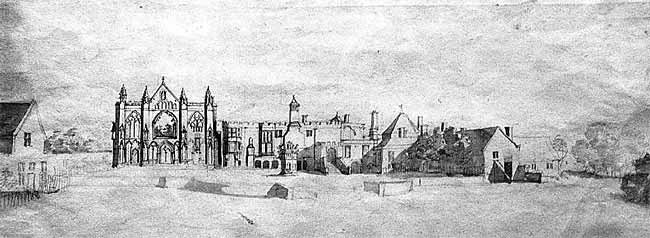Articles from the Thoroton Society Newsletter
Another picture of Newstead Abbey
By Pete Smith FSA
Whilst the painting of Newstead Abbey which has been purchased in memory of Dr Rosalys Coope languishes, unrestored, at Newstead due to Covid-19, yet another eighteenth century image of the Abbey, a drawing this time, has come onto the London art market (Fig. 1). The gallery, Artware, attribute this pen and wash drawing (16 x 47cm) to Peter Tillemans with good reason. It is remarkably similar in style and technique to the pen and wash drawing by Tillemans now at Newstead, though with significant architectural and vegetative differences (Fig. 2).

Fig. 1. Peter Tillemans (attrib.) A Panorama of Newstead Abbey, Nottinghamshire, c. 1734. © Artware.

Fig. 2 Peter Tillemans. The west front of Newstead Abbey, Nottinghamshire, between 1720 and 1726. NCMG
The drawing now at Newstead (Fig. 2) must date to sometime between 1720, the date the Conduit was moved from the cloister to before the west front of the house, and 1726 the date of Buck’s drawing, which shows that a number of small alterations had taken place in the intervening years. The new drawing (Fig. 1) illustrates further changes made to the west front around 1730 and must therefore date to sometime between 1730 and Tillemans’ death in 1734. Tillemans was employed at Newstead in the 1720s and 30s not only to produce pictures of the Abbey but also to teach the 4th Lord Byron how to paint. Tillemans last and largest oil painting of the west front of the Abbey was left unfinished at his death and was completed by the 4th Lord before his own death in 1736. This new drawing was almost certainly created by Tillemans as a study for this late oil painting and was most likely taken in 1733 or ’34.
The architectural changes clearly visible in the later drawing include the removal of the prominent external chimney stack to the north of the porch and its removal to the east side of the hall, plus its replacement with a third tall bay window, an exact replica of the late-medieval bay window, probably built for Prior William Sandall between 1504 and 1526, to its north. There is slight shift in viewpoint between these two drawings and the shading indicates that they were taken at different times of day - early afternoon for earlier drawing (Fig2) and late evening for the later one (Fig. 1) - whilst the foliage on the trees suggests that both drawings were taken at mid-summer. But the most obvious difference is seen in the growth of these trees. Those on the right hand side of the image - screening the service range - have increased in height significantly, as one might expect after the maximum 14 years. These trees and the shift in viewpoint must explain why the pyramidal kitchen roof, so prominent in the earlier drawing, is hidden from view in the later drawing. Similarly the trees on the left of the picture have put on so much growth that the small building seen on the extreme left in the earlier drawing (clearly seen in an engraving of 1749) has been engulfed by them. The only other significant difference is in the low curved front walls which are more clearly delineated in the new drawing. It is extremely unusual to find two such accurate and similar drawings of before and after alterations to a country house by the same artist and it is to be hoped that the Nottingham City Museums and Galleries will be able to raise the funds to acquire this drawing for the Newstead Collection so that these drawings can be reunited. The City has previously taken every opportunity to acquire important and significant works which relate directly to the house and the family’s history. This newly discovered drawing by Peter Tillemans, one of the most important topographical artists of his day, is one more important piece in the jigsaw which is the history of Newstead Abbey. The paintings and drawings in the Newstead Collection by Tillemans, Samuel Buck, the 4th Lord Byron, S H Grimm, Cornelius Varley and Thomas and Maria Wildman have all contributed hugely to our understanding of how this house developed. The discovery of this new Tillemans drawing is also a hopeful reminder that new information is still waiting to be found or as in this case identified. For further details see - artware fineart.
< Previous